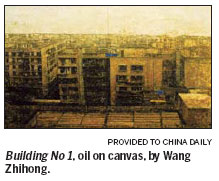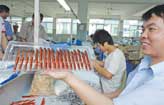People
Sichuan artist looks behind the facade of old buildings
Updated: 2011-07-14 07:58
By Daniel Garst (China Daily)

Talented artists can make mundane objects seem interesting and full of mystery.
Sichuan artist Wang Zhihong's newest paintings, now on display at 798 XYZ Gallery, have done just that, targeting buildings and apartment blocks in third-tier Chinese provincial cities, like those of his hometown of Luzhou, in Sichuan province.
Wang grew up there in the 1960s and 1970s in a large family. He credits his father, who was a publicist at a factory, for supporting his artistic leanings. Wang says that while life in these decades was not easy, people then had a "special spirit". That spirit was forged by communal living.
"Everyone's home was open, we often shared food with our neighbors and could also hear them quarreling as we sat on the rooftop of our two-story building," he says.
This building is depicted in two paintings, The Big Tree and My Childhood Home. Both paintings convey the structure's smaller, human scale, which is accentuated by the trees surrounding it. Indeed, in the former, the building gives way entirely to nature. "The building still stands, people still live in it, but not as many as before," Wang says.
That nature and humanity is missing from the newer seven-story apartment blocks depicted in Building No 1, which expresses Wang's sadness over how Luzhou has changed. He says that these buildings remind him of "prisons".
Both nature and people are absent from this painting. "It does have people; behind each window is a family, but there is much less community among them compared to when I grew up," he says.
One painting, Building No 8, has both people and buildings. While viewers readily sense what it represents, the painting has a strong expressionist feel, as the structures and crowd around them merge into a blurry urban dreamscape.
Wang did this painting in a "subjective mood", adding that he wanted to both "be spontaneous" and "destruct reality".
Finally, in another notable painting, Building No 2, the building almost seems to be alive. The painting depicts a three-story apartment block whose leaning front makes it appear to be lunging or marching forward.
Wang's focus on buildings reflects his art education. When attending the Sichuan Academy of Fine Arts in the early 1980s, he and the other students were taught in the Russian "socialist realism" style.
"We knew nothing about abstract expressionism, but devoured all of the books in the library dealing with French impressionism," he says.
Thus while the subject matter, working class apartment blocks, follows socialist realism cannons, the soft and blurry depiction of them is akin to impressionist painters, especially Monet. The subdued light in the paintings also reflects Sichuan's cloudy weather. And Wang cites two Chinese painters, Bada Shanren, from the Qing Dynasty (1644-1911), and Huang Gongwan, from the Ming Dynasty (1368-1644), as key influences on his work.
Wang moved to Beijing in 2010, to paint full-time, after working as an interior decorator in Luzhou. His big break came when the painting, Fragrance in an Ancient Street, won first prize in a National Art Competition. However, he plans to remain focused on Luzhou, but will shift from painting buildings to "in depth" portrayals of its people.
As China continues its rapid urbanization, cities like Luzhou will be changed beyond recognition, mainly for the better. But Wang Zhihong's paintings make one realize that there was more to old Luzhou's seemingly drab and ordinary buildings than meets the eye.
Wang Zhihong's paintings are on exhibit through August at the 798 XYZ Gallery.
For China Daily

Specials

90th anniversary of the CPC
The Party has been leading the country and people to prosperity.

The write stuff
'Pen capital' goes back to drawing board for answers to economic changes taking shape in Zhejiang

Say hello to hi panda
An unusual panda is the rising star in Europe's fashion circles